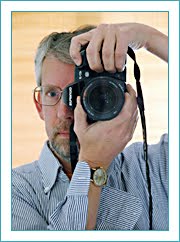From Karuizawa, I headed to Kanazawa, north, on the Sea of Japan side of Japan's main island of Honshu. I chose to stop at Kanazawa for a number of reasons. First, I visited Kanazawa last year and was particularly impressed by Kenrokuen, said to be one of Japan's three most beautiful gardens. Last year, the grounds were full of birds, so I had hopes of seeing more. Second, I noticed that Kanazawa has a large museum of contemporary art that I thought might be worth a visit. Third, on my last visit, I thought Kasazawa interesting for its mix of the very modern and the traditional. And so I ended up in Kanazawa. The hotel I found was comfortable, inexpensive, and conveniently located and the buses in Kanazawa are easy to use, making it easy to get around.
The museum, The 21st Century Museum of Contemporary Art, was rather disappointing. So much of what passes for art these days leaves me cold. It tends to be slick, manufactured, and propped up by theory. It often lacks any kind of human messiness. I thought the chairs in the associated library of art books more interesting than most of what was on display.
There is always an awful lot of empty space in these most modern of museums that seems wasteful. One section hosted an independent exhibition of Western style painting, photography, and sculpture that was more densely exhibited. The photography was the most interesting.
Kenrokuen turned out to be something of a disappointment too. With the exception of a few pigeons and crows, I saw no birds at all. The few birds I heard I was unable to locate. The gardens were pretty, though, and because Kanazawa is considerably cooler than Tokyo, the cherry blossoms were again at their peak, a few days behind Tokyo. So I joined the crowds. I noticed a fair number of people in traditional dress, which can be rented nearby if you feel like going back in time during your visit to the gardens.
A tourist map I picked up at Kenrokuen noted the "Kanazawa Phonograph Museum" well north of the gardens, about a 15-minute walk. After a quick stop for lunch I headed for the museum, which turned out to be a lot of fun. On the way, I came across an interesting art deco style building that I learned was built in 1935 as a retail store. It had a plaque noting that it was on a register of protected buildings. According to the plaque, it is one of Japan's earliest reinforced concrete structures. I particularly liked the brickwork at the base of the walls and the emerald green tile accents on the facade.
What is a phonograph? I'd never really thought about it before. The museum houses more than 500 phonographs and a collection of more than 20,000 records and cylinders all collected by one Hiroshi Yokaichiya. His son today is the curator of the collection, which no belongs to the city of Kanazawa. Three times a day he demonstrates some of the phonographs on display. His father owned a record store. When, in the early 1950s, phonographs were being replaced by modern record players, and Japan was rapidly modernizing and all fronts, phonographs were being thrown away. Mr. Yokaichiya thought it a shame that so many were being lost, so he began collecting and repairing them.
The history goes back to 1877, when Charles Crowe (in France) proposed a viable method of recording sound and, in the same year, Edison invented a foil-wrapped cylinder to record sound, which he later improved upon (wax and later celluloid cylinders were employed). Eventually flat discs made of ebonite and later lacquer-coated paper were developed. Initially only one side was used. These later evolved into two-sided 10-inch lacquer discs and later the two-sided, 12-inch LP records we still use today.
A phonograph is entirely mechanical. Although the fanciest models sometimes had electric motors to rotate the platter and the fanciest of them all – multi-disc changers, precursors of the juke box – used motors to load, flip, and unload records, phonographs do not have amplifiers. The stylus (most often steel, but bamboo and cactus spines were used, and later sapphire and diamond styli were developed) is connected to a "sound box" that houses a diaphragm that vibrates as the needle traces the etched groove in the record (diaphragms were made of everything from duraluminum to mica). That sound passes through a hollow tone arm connected to a chamber of some kind that ends in a flared cone, or trumpet.
The sound quality and volume are mostly dependent on the design of the channel between the vibrating diaphragm and the trumpet. The most advanced units were large pieces of furniture with complex, folded tubes as long as 10 feet. These were very expensive in Japan (mostly made in England and the US). According to Mr. Yokaichiya, some cost as much as a house. Many cost two to three months of a typical salary at the time. All of the machines that he demonstrated produced much better sound than I imagined they would before hearing them.
Listening to the demonstration I attended (I happened to arrive just as one was starting), a young Japanese man who said his business was repairing accordions was there and a young Frenchman joined us. I translated for him. Mr. Yokaichiya seemed to really enjoy talking about the history of the phonograph in Japan and, at the end of the talk, he insisted on taking a photograph of the three of us together, as if we were old friends, despite the fact that we had all just met. Well worth a visit if you happen to find yourself in Kanazawa.















No comments:
Post a Comment